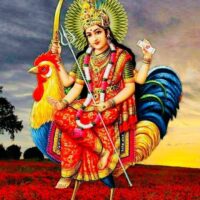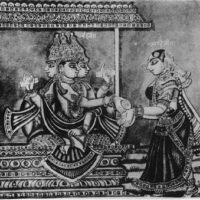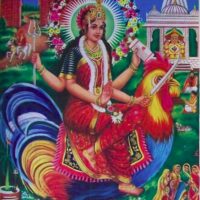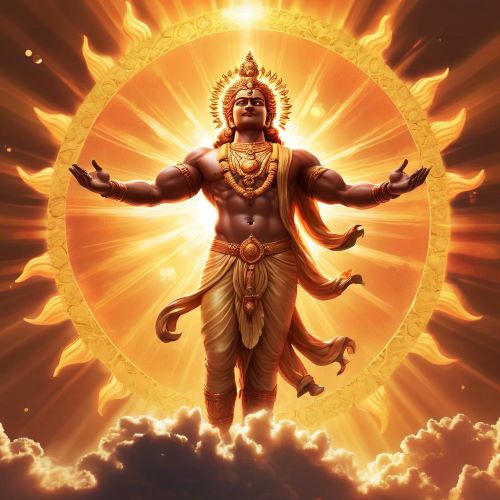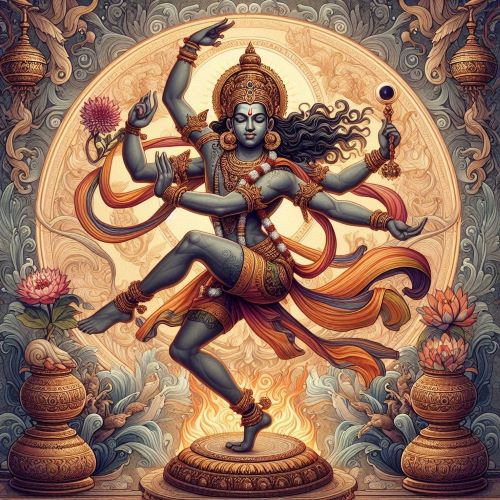Aditi : The Cosmic Mother
Listen
At a glance
| Description | |
|---|---|
| Origin | Indian Mythology |
| Classification | Gods |
| Family Members | Sage Kashyapa (Husband), Varuna, Mitra, Surya, Bhaga, Aryaman, Indra, Vamana, Savitr, Rudras and Vasus (Children) . |
| Region | India |
| Associated With | Motherhood |
Aditi
Introduction
Aditi, a central figure in early Hindu cosmology, is revered as the eternal mother of the gods—the Adityas. As her name suggests, meaning “limitless” or “boundless” in Sanskrit, Aditi embodies the infinite expanse of space, the sky, and the universal womb from which all life emerges. Her significance originates in the Rigveda, where she is often invoked in hymns praising her as the nurturing force behind creation and cosmic order. Rather than representing a single role or function, Aditi symbolizes wholeness and liberation, bridging the metaphysical with the maternal. She is a deity of abstraction—an eternal source beyond form, embodying the freedom of the unmanifest universe.
Physical Traits
Aditi is not typically represented with the anthropomorphic clarity seen in other deities, as her nature leans toward the abstract and universal. However, in select depictions, she may be shown with multiple arms bearing divine symbols such as a lotus for purity, a sun disc for her association with solar energy, and sometimes a sword or trishula to signify protection and cosmic authority. Her earrings, once stolen by the asura Naraka and retrieved by Krishna and Satyabhama, are an unusual symbolic detail that hint at her divine status and connection to celestial order. She is also associated with the phoenix—suggesting cyclical renewal and infinite creation. Occasionally visualized as a divine cow, Aditi represents fertility, nourishment, and the sustaining power of the Earth.
Family
Aditi belongs to a divine lineage rooted deep in Vedic tradition. She is the daughter of Daksha and Asikni, and her marriage to the sage Kashyapa places her at the center of many cosmic genealogies. With Kashyapa, she gave birth to twelve Adityas, including well-known deities such as Varuna, Mitra, Surya, and Bhaga, who together govern aspects of cosmic law and natural forces. She is also the mother of Indra, the king of gods, and Vamana, the fifth avatar of Vishnu. Aditi’s siblings include Diti, the mother of demons (Daityas), which sets up a cosmic polarity between forces of light and dark. This familial contrast reflects the tension between order and chaos that underpins Hindu mythology. Through her divine motherhood, Aditi becomes the source of not just divine beings, but of cosmic principles themselves.
Other names
The many epithets of Aditi reflect her vast and all-encompassing nature. She is frequently called Devamata, the “Mother of the Gods,” and Vishvamata, the “Mother of the Universe,” emphasizing her nurturing essence. These titles highlight her role as a maternal protector and progenitor of celestial order. In various Vedic hymns and later philosophical texts, she is also identified with the “primordial substance,” Prima Materia, the foundational element from which existence arises. In the Shatapatha Brahmana, Aditi is equated with the Earth, the sky, and even the ritualistic water of space, signifying her presence in every realm of creation. Her very name denotes freedom, underscoring her identity as one who is unbound by worldly constraints.
Powers and Abilities
Aditi’s powers are less about spectacle and more about fundamental, cosmic function. As the embodiment of the infinite, she governs the elements that frame human existence—space, consciousness, time, and fertility. She is called upon in Vedic hymns for protection, prosperity, and the removal of obstacles. Her role as liberator is especially significant; she is often invoked to unbind worshippers from sin, misfortune, and the ties of mortality. This power of unbinding connects her to her son Varuna, who enforces ṛta, the moral and cosmic law. In the cosmic narrative, Aditi also plays a key part in restoring balance by urging Vishnu to take birth as Vamana, a divine incarnation meant to subdue the demon king Bali. Aditi does not merely nurture; she acts decisively to maintain equilibrium across the universe. Her essence, associated with mulaprakriti (primordial nature) in Vedanta, ties her to the very fabric of existence—serving both as origin and sustainer.
Modern Day Influence
While Aditi is not widely worshipped in temples or celebrated in large-scale festivals today, her philosophical imprint is visible in numerous cultural and intellectual domains. Artists, writers, and thinkers often reference her archetype of boundless creation and maternal grace. Contemporary artists like Aditi Hazra and Aditi Singh channel cosmic and spiritual themes that echo her symbolism, blending traditional motifs with modern interpretations. In literature, Aditi Machado’s poetic works explore themes of language, identity, and consciousness—resonating with the goddess’s association with Vāc, or divine speech.
In the world of technology and science, the name “Aditi” has found its way into academic tools and computing platforms, such as the logic programming system developed by the University of Melbourne. This is perhaps a fitting tribute to a goddess whose identity is tied to boundless knowledge and interconnection. In the social sector, Aditi Gupta’s Menstrupedia project uses her name to promote education and de-stigmatization around menstruation, especially in regions where ancient taboos still prevail. This modern reclamation of her name aligns with Aditi’s original nature as a nurturing and liberating force for all beings.
Fashion labels like Aditi Collections also draw from her identity to blend heritage and modernity, showcasing how mythological symbols continue to shape cultural expression. Though Aditi may not be a household name in contemporary devotional practice, her influence endures through philosophy, feminism, art, and the continuing Indian exploration of cosmic unity and maternal strength.
Related Images
Source
Britannica. (n.d.). Aditi Vedic Goddess, Mother of Gods & Cosmic Order. Retrieved from https://www.britannica.com/topic/Aditi
Ramana Maharshi Foundation. (n.d.). Aditi: The Mother of the Devas. Retrieved from https://www.ramana-maharshi.org/aditi-the-mother-of-the-devas/
TimesLife. (2025, July 3). Aditi: The Forgotten Cosmic Mother of Hindu Mythology. Retrieved from https://timeslife.com/spiritual/aditi-the-forgotten-cosmic-mother-of-hindu-mythology/articleshow/122231464.html
Wikipedia contributors. (n.d.). Aditi. Wikipedia. Retrieved August 1, 2025, from https://en.wikipedia.org/wiki/Aditi
L Durdin-Robertson. (1979). Communion with the Goddess: Idols, Images and Symbols of the Goddesses: India. https://www.fellowshipofisis.com/ldr7_india.pdf
Frequently Asked Questions
What is lorem Ipsum?
I am text block. Click edit button to change this text. Lorem ipsum dolor sit amet, consectetur adipiscing elit. Ut elit tellus, luctus nec ullamcorper mattis, pulvinar dapibus leo.
What is lorem Ipsum?
I am text block. Click edit button to change this text. Lorem ipsum dolor sit amet, consectetur adipiscing elit. Ut elit tellus, luctus nec ullamcorper mattis, pulvinar dapibus leo.
What is lorem Ipsum?
I am text block. Click edit button to change this text. Lorem ipsum dolor sit amet, consectetur adipiscing elit. Ut elit tellus, luctus nec ullamcorper mattis, pulvinar dapibus leo.
What is lorem Ipsum?
I am text block. Click edit button to change this text. Lorem ipsum dolor sit amet, consectetur adipiscing elit. Ut elit tellus, luctus nec ullamcorper mattis, pulvinar dapibus leo.
What is lorem Ipsum?
I am text block. Click edit button to change this text. Lorem ipsum dolor sit amet, consectetur adipiscing elit. Ut elit tellus, luctus nec ullamcorper mattis, pulvinar dapibus leo.



